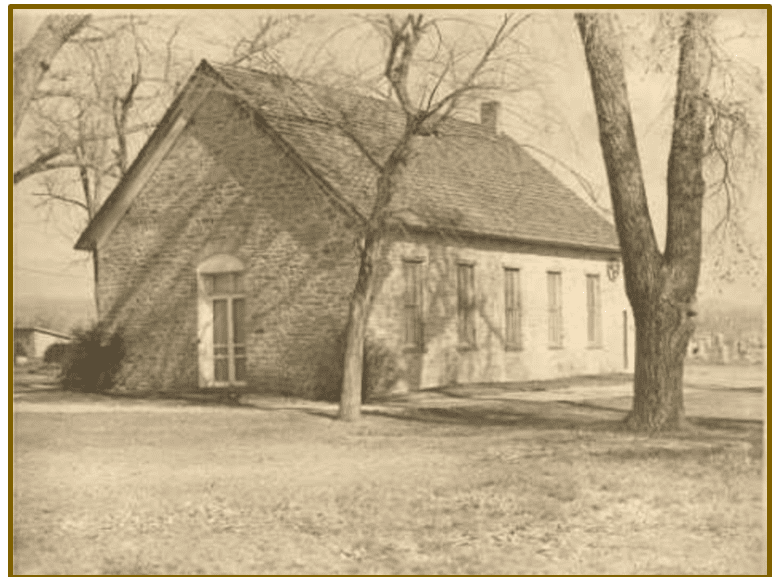
The Old Dunkard Church was originally built in 1888
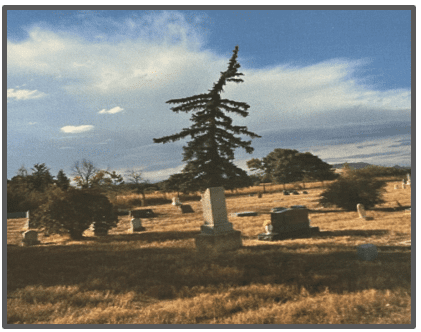
The cemetery where several members of the Knoll and Bashor families are buried in Hygiene is on the property of the Dunkard Church. It is located at 7940 Hygiene Road, Longmont, Colorado 80503.
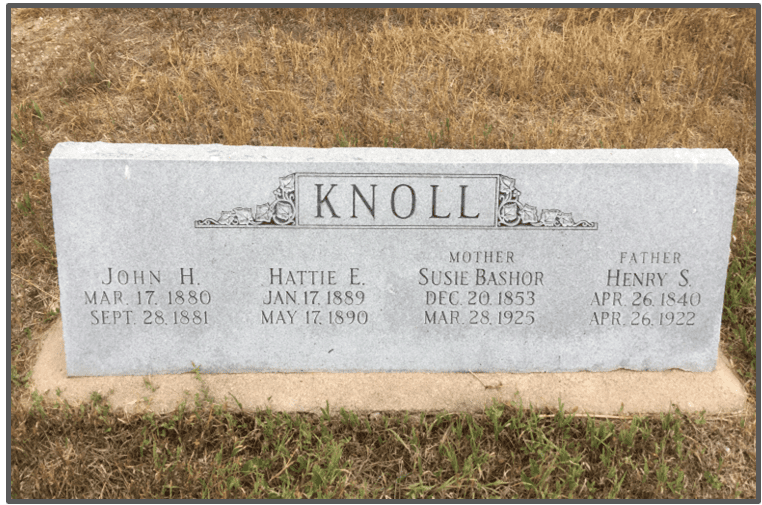
Hattie died a few months after the family home caught fire and burned down in March of 1890. Edith Stella was five years old when her sister, Hattie, passed away. The family lived in a tent in one of the coldest months of the year. It is guessed that Hattie caught pneumonia during that time and did not survive. The townspeople arranged a fundraiser to assist the family so they could rebuild their home.
Reports from The Longmont Ledger reported the following of the fire and its aftermath:
*March 11, 1890, Longmont Ledger, Highlandlake column: Henry S Knoll's house was burned to the ground Sunday afternoon with all the contents, the family escaping with just what they had one.
*April 4, 1890, Longmont Ledger, Highlandlake column: Contributions of money, clothing and food from Longmont, Berthoud, and Highlandlake have come in for the Knoll family. They are living in a large tent and expect to build soon.
*May 11, 1890, Longmont Ledger, Highlandlake column: Death of Hattie Knoll, one year, four months. Caught a series of colds while living in the tent after the house burned down. Other children and Mrs. Knoll also sick. Their tent is like a hospital.

Susannah’s parents, John and Elizabeth Bashor (Edith Stella’s grandparents)
The Bashors and Zeitchs came to America from Waldorf, Germany, a distance of 300 kilometers to Holland. One-thousand and sixty-five people were on the ship to America, arriving 7 weeks after departure in Baltimore, Maryland and then on to Pennsylvania.
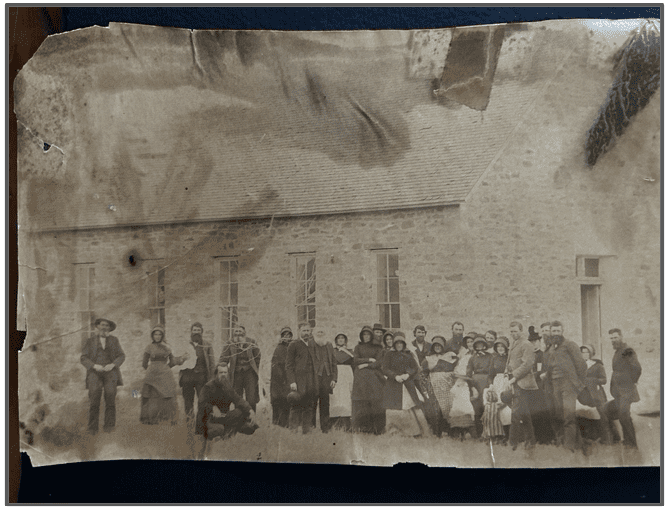
Photograph from O.G.B. photo album. Elizabeth Bashor is likely the largest and shortest woman in the picture. Standing in front of two men. She is wearing a light-checkered apron and bonnet. Henry Knoll appears to be the man in the rear to her right behind the ladies dressed in dark clothing with dark bonnets standing side by side. Only Henry’s head is showing.
“In the early years the Dunkard families attended a church which was located not far from the foothills. As was the custom, the church had their own graveyard.
When the Knoll home was sold, for her share, Edith Stella received $1,000 dollars in cash prompting Orville to write the following “The one weakness H.S. Knoll had was that he gave too much to the Dunkard Church.”
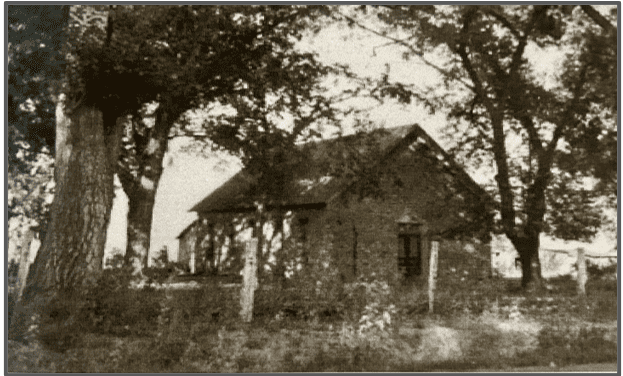
SOURCE: The Daily Times Call (August 29, 1996) Bashor Family Got Solid Start in Early Longmont, by Betty Ann Newby
The Church of the Brethren, also known as the St. Vrain Church of the Brethren and the Old Dunkard Church, is an historic Church of the Brethren meeting house located on Hygiene Road (17th Avenue) in the small community of Hygiene (3/4 mile west of Longmont) in the St. Vrain Valley of Boulder County, Colorado. To the rear of the church is a small cemetery where many of the early members of the congregation are buried. In 1874, formal organization of the Church of the Brethren was held at the ranch home of Mr. and Mrs. J. R. Ullery and led by the itinerant preacher, James R. Gish.
Origin of terms Hygiene and Dunkers:
The word “Hygiene” was first used in the English language in the late 17th century and comes from the Greek root, “the art of health.” Hygieia was the daughter of the God of Medicine, Asclepius. Hygieia practiced the art of health, cleanliness, and sanitation. During the Reformation in Germany in the early 18th century, a religious group, called the Church of the Brethren, was persecuted for its beliefs. This group was also known by the nickname “Dunkers,” for their baptism ceremony, in which people are ‘dunked’ three times. Dunkers first immigrated to Holland, where they experienced more tolerance. Unfortunately, by the 1840s, the Dutch persecuted them as well.
A Dunker group left for America, settled in Iowa and named the town Pella. With more than 10,000 residents today, it is a vibrant, well-established community with an annual tulip festival and the largest Dutch-style windmill in the United States. The town grew quickly, causing land to become scarce and expensive. In the 1870s, three groups left to make new settlements in Nebraska, Iowa, and Texas, which they named Pella, mostly likely because of the name’s religious connection and/or desire for refuge. The towns in Texas and Nebraska no longer exist except for a road name or cemeteries. Our own Pella was absorbed by Hygiene in 1916.
The first influx of Brethren came to Colorado from Iowa, settling south of Hygiene in Pella, Colorado. Reverend Jacob S. Flory left Greeley, Colorado with his wife and eight children to carry on the work of the church. He also must have had a good eye for developing business opportunities. Within 10 years, Flory built the Hygienic House, a sanitarium located close to the area that became Hygiene. At the time, people from all over were taking advantage of Colorado’s climate that brought relief to those suffering from tuberculosis. It is said that in 1900, up to 30 percent of residents were here for treatment. Flory moved on to California; the sanitarium became a hotel and was torn down 10 years after Hygiene and Pella consolidated in 1926.
In April 1879, land for the church and cemetery was donated to the Church of the Brethren by George and Lucinda Mason. In 1888, the building was erected of rough-cut stone, which came from Lyons and was laid in coarse, unequal thickness. The total cost of construction, including donated labor, was $2,000. The Hygiene Cemetery surrounded the church, with the original Pella Cemetery lying to its south. Church services were suspended in 1907. In 1984, the church building and the land surrounding it were added to the National Register of Historic Places. In 2004, the Hygiene Dunkard Church was awarded landmark status in Boulder County. In 2009, the church was deeded to the Hygiene Cemetery Association, which thereafter launched restoration efforts. It is the oldest Brethren church still standing in Colorado.
Church of the Brethren Beliefs
Baptism: Baptism triple immersion is an ordinance performed on adults, in the name of the Father, Son, and Holy Spirit. Brethren see baptism as a commitment to live Jesus' teachings responsibly and joyfully.
Bible: Brethren use the New Testament as their guidebook for living. They believe the Bible is divinely inspired and the Old Testament lays out God's purpose and desires for humanity.
Communion and Creed: Communion is an expression of love, modeled after Christ's last supper with his disciples. The Brethren partake in bread and wine, celebrating agape, the selfless love Jesus showed to the world. Brethren do not follow a Christian creed. Rather, they use the entire New Testament to affirm their beliefs and to glean instruction on how to live.
God: God the Father viewed by brethren as "Creator and loving Sustainer."
Healing: The practice of anointing is an ordinance within the Church of the brethren and includes the minister laying on of hands for physical, emotional, and spiritual healing. Laying on of hands symbolizes prayers and support of the entire congregation.
Holy Spirit: Hold the faith that the Holy Spirit is an integral part of the believer's life: "We seek to be guided by the Holy Spirit in every aspect of life, thought, and mission."
Jesus Christ: All brethren "affirm their belief in Jesus Christ as Lord and Savior." Living a life patterned after the life of Christ is of paramount importance to the brethren as they seek to emulate his humble service and unconditional love.
Peace: War is a sin according to the Church of the Brethren. Brethren are conscientious objectors and seek to promote nonviolent solutions to conflict, ranging from personal disagreements to international threats.
Salvation: God's plan of salvation that people are pardoned from their sins through believing in the atoning death of Jesus Christ. God provided his only Son as the perfect sacrifice in our place. Jesus promises believers in him a place in heaven.
Trinity: Believe in the Trinity of Father, Son, and Holy Spirit; three distinct Persons, each Person is fully God, and there is only one God.
Worship Practices
Sacraments: Brethren recognize the ordinances of adult believer's baptism, communion (which includes a love feast, bread and cup, and feet washing), and anointing. Baptism is by immersion, three times forward, in the name of the Father, of the Son, and of the Holy Spirit. This triple immersion method of baptism earned the Brethren the nickname “Dunkers.” Following baptism, the most significant ordinance is the love feast, which brings the Brethren together for a time of communion and concentrated fellowship. Anointing is a healing rite for a believer who is emotionally or spiritually upset or physically ill. The minister anoints the person's forehead with oil three times to symbolize forgiveness of sin, strengthening their faith, and healing of their body, mind, and spirit.
Worship Service: Church of the Brethren worship services are informal, with prayer, singing, a sermon, sharing or testimonies, and communion, love feast, feet washing, and anointing. Some congregations use guitars and wind instruments while others feature traditional worship music.
Simple Living: Brethren practice a simple, non-conforming way of life. Until the early 1900s, the church required its members to dress plainly. Today's Brethren still seek simplicity in all areas of life.
